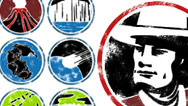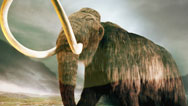Extinction Happens
- By David Levin and Julia Cort
- Posted 11.01.06
- NOVA scienceNOW
While the mass extinction that decimated the dinosaurs 65 million years ago may be more famous, Sam Bowring, a professor in the Department of Earth, Atmospheric, and Planetary Sciences at MIT, explains why we all should know about another, even greater biotic wipeout, the Permian extinction.
 Listen
Listen
MIT geologist Sam Bowring muses on mass extinctions and why we can't take Earth's hospitable climate for granted.
Transcript
Extinction Happens
Posted: November 1, 2006
DAVID LEVIN: You're listening to a NOVA scienceNOW podcast.
Two hundred fifty million years ago was not a good time to be on Earth. Something wiped out the vast majority of animals in the ocean and may have decimated life on land as well. Scientists are now trying to piece together exactly what happened and, perhaps more importantly, if it could happen again.
NOVA scienceNOW's Julia Cort spoke to Sam Bowring of MIT about this mother of all extinctions.
JULIA CORT: So just how big was the extinction at the end of the Permian period? How important was it for the history of life?
SAM BOWRING: Based on what we know of the fossil record, this is probably the most profound extinction of animal life that we have ever seen on this planet. You know, the estimates are 90 percent of everything that lived in the oceans went extinct. So it completely changed the course of evolution.
JULIA CORT: A lot of people have heard about how an asteroid helped kill off the dinosaurs at the end of the Cretaceous, 65 million years ago. What do you think about speculation that an asteroid caused the Permian extinction as well?
SAM BOWRING: I say those who invoke asteroids as the killing mechanism for every extinction lack imagination. We have one example that has been reasonably proven, but not absolutely proven, caused an extinction. And so people are happy to invoke that for every extinction. Sure, it could have been an asteroid, but there's absolutely no evidence for an asteroid.
So I say, why invoke it? Why not look for something a little bit different? Maybe asteroids are just too simple. The Earth is hit by asteroids all the time – big ones. Doesn't cause mass extinction.
JULIA CORT: Do you think in the case of the Permian, we should not point fingers at just one simple cause?
SAM BOWRING: Yeah, and even though, you know, for the best example, the K-T extinction, even though most people accept that an asteroid impact had a huge effect on the extinction, there's still a lot of vigorous, intellectual debate over what exactly happened.
And why? Because we're getting better and better at teasing information out of the rock record, and I think there's a lot more to be found out – lot we can learn about how this planet operates, what crises this planet can survive and what it can't survive. Those sorts of questions are what I think really drives a lot of Earth scientists.
JULIA CORT: Does studying these mass extinctions offer us any lessons for today?
SAM BOWRING: I think there are some lessons for today and that is to really try to understand the time scales of changes on this planet. Humans, you know, as a species haven't been here very long. We've yet to prove ourselves as a viable species so we tend to be a little overly infatuated with ourselves.
If humans went extinct today, would we see it in the fossil record 100 million years from now? There might be a thin layer of debris of Cadillacs and Explorers and things, but there might not be very much there.
Maybe for all we know, we will never see conditions like this again in terms of low CO2 in the atmosphere, equitable climate over much of the planet. You know, maybe we'll see that this was really an unusual time and led to this rapid diversification and expansion of the human species. We don't know.
JULIA CORT: And it's not conceptually difficult for you to think that the environment for life can sort of implode because of forces on Earth.
SAM BOWRING: No, not hard for me to think about that at all. Humans are not much different than many of the animals that existed right before the Permo-Triassic extinction. We're over-specialized. We couldn't cope very well if there was a massive change to the planet. Just think if tomorrow you woke up and had nothing – no cars, no buildings, no stores – how well do you think you'd do out there on the streets? Not very well.
We know for a fact that there have been huge changes in the environment and climate change. Fifty-five million years ago things warmed up dramatically, caused huge changes in the organization of the ecosystems. That could happen again today. No asteroids required. But we as a species will have to be completely reorganized on this planet, and a small percentage would survive a change like that.
JULIA CORT: So the Earth isn't this nice, little, calm, steady, always-the-same kind of place?
SAM BOWRING: It depends on your perspective of time. So if you think only about your lifetime, that's probably a fair description. Except for the odd tsunami or earthquake or volcanic eruption.
But if you start thinking about tens of thousands of years, fifty thousand years, hundred thousand years, not to mention millions of years, the Earth is an incredibly dynamic place. A lot's happening – lots happening to the environment, lots happening to climate. And we have to understand those changes if we want to survive.
DAVID LEVIN: To find out more about the mother of all extinctions and its lessons for today, watch the November 21 episode of NOVA scienceNOW on our web site at pbs.org/nova/sciencenow.
Credits
Audio
- Produced By
- David Levin and Julia Cort
- Edited by
- David Levin
Images
- (all)
- © NOVA/WGBH Educational Foundation
Related Links
-

Mass Extinction
What caused the Permian extinction—the mother of all extinctions—250 million years ago?
-

Permian Prime Suspects
Examine a lineup of possible culprits in the Permian extinction and cast your vote in our poll.
-

Mass Extinction: Expert Q&A
The Smithsonian's Doug Erwin answers questions about the Permian and other mass extinctions.
-

Megabeasts' Sudden Death
Scientists propose a radical new idea of what killed off mammoths and other large animals at the end of the Ice Age.
You need the Flash Player plug-in to view this content.



